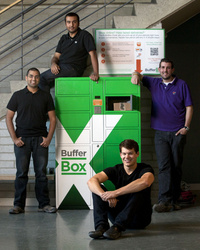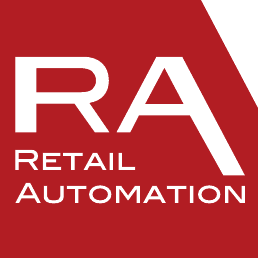WATERLOO -- What started out as an idea for solving the annoying problem of having to be home for parcel pickups has evolved into a high-tech delivery business that is ready to roll out in big cities.
After a successful trial run in Waterloo, BufferBox, a new type of community mailbox that allows people to pick up parcels at any time of the day or night, plans to expand into Toronto this summer.
BufferBox Inc. founders Mike McCauley, Aditya Bali and Jay Shah have been running a successful parcel delivery kiosk at the University of Waterloo Student Life Centre. Now the UW grads, plus new employee Bradley Moggach, are ready to set up a network of BufferBox kiosks in Toronto, to be located in subway stations and other locations where there is 24-hour pedestrian traffic.
"We will soon be closing a round of financing, and that will really help us accelerate our launch in Toronto," McCauley says. "By the end of the year, we hope to have 20 locations in Toronto."
After Toronto, the company hopes to set up kiosks in other large Canadian cities.
BufferBox has come a long way since its inception in 2010 as a fourth-year mechatronics engineering project aimed at solving an annoying parcel delivery problem. University students get numerous parcels, but they are rarely home to receive them. After several failed parcel delivery attempts, they have to make their way to a far-flung depot to retrieve it.
That led to the idea for a "community mailbox meets ATM machine" for parcel delivery. The students won several big entrepreneurial contests for the concept and prototype. After they graduated last year, they immediately launched the company.
The original idea was to partner with big delivery companies, such as Canada Post and FedEx. But in speaking to people in those organizations, McCauley and his team were encouraged to prove their concept first.
"It takes a long time for big corporations to adopt a technology like this so, we are keeping in contact with them. But right now we are focusing on developing our core technology, executing on our plan, getting into Toronto and creating some traction," McCauley says. "Eventually, maybe Canada Post or FedEx will want to do something with us."
In January, the enterprising students set up an 11-compartment BufferBox kiosk in UW's Student Life Centre. They have delivered more than 700 parcels at the kiosk.
You sign up for BufferBox at the company's website and use PayPal to buy credits to pay for parcels you want delivered to a BufferBox kiosk. Your parcels then get directed to a BufferBox delivery address. When the parcels arrive at the kiosk, you get an email that contains a randomly-generated pin code. You go to the kiosk at your convenience, type in the pin code and retrieve the parcel.
"With the deliveries we have done so far, we have had zero issues with security," McCauley says. BufferBox kiosks will be in highly visible locations, such as subway stations and university student centres, making it difficult for anyone to attempt to break into the compartments, he says.
"We've tried to achieve a balance of security and flexibility."
The company is integrating its system with e-retailers who are interested in developing a simpler way for people to get their products when they shop online.
For example, UW's bookstore has allowed students to select the BufferBox delivery option as part of its online ordering system. "That worked really well for students who want their books delivered," McCauley says. "It was a great experience for us in testing out e-retailer integration. When we move into Toronto and integrate it with other e-retailers, we will have this experience under our belts."
The Toronto kiosks will contain as many as 52 compartments and have a more sophisticated touchpad screen for entering the pin code and for giving customers information. The original UW site will also get a bigger kiosk.

The prototype was manufactured in China, but with more kiosks in the works, the team has shifted to a local manufacturer to produce the steel boxes. "With the higher volume, it was actually cheaper to use an Ontario manufacturer and we get a much faster turnaround," McCauley says.
The company will partner with Toronto-based courier companies to get parcels to the kiosks. "These smaller delivery companies will be able to help us with logistics side of what we are trying to do," McCauley says.
The system has the potential to solve a lot of problems, for both customers and retailers, he says.
"From the customer perspective, you can have anytime pickup. You also get an email so you know that you have a parcel waiting for you, as opposed to going home and finding a failed delivery notice."
From the retailers' point of view, it makes e-commerce more convenient, he says.
Right now, BufferBox is set up only for receiving parcels, but McCauley envisions that with more advanced automation systems it could also be used for sending out parcels. "That's where we hope we can partner with corporations like Canada Post or FedEx," he says.
Having the ability to send parcels back through the kiosk would be a boon for retailers, says McCauley, as one of the biggest barriers to online buying is the feeling that it is too difficult and expensive to return products.

